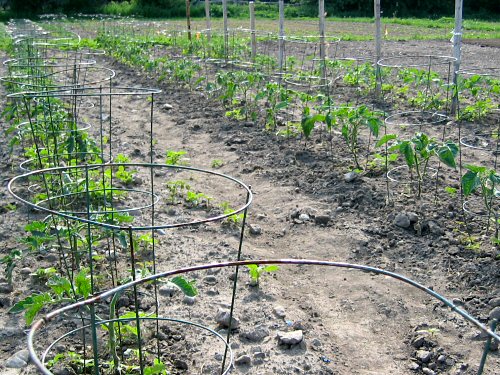
Prune, sucker, stake and cage—there’s a lot of (brutal-sounding!) stuff to do with tomatoes. On the other hand, as I’ve done in past years, simply by not having enough time to support them all, you can let ’em sprawl. I’ve always wanted to have the toms neatly assisted by the basket-weave method. This involves pounding in stakes every second plant (maybe every third would also work), then weaving twine in and out, in front then behind every other plant in one direction, then back again, weaving the opposite way, this done every 12″ or so of growth. This way, each plant is then supported by twine on both sides. You also have to prune and sucker (remove the shoots that grow at the intersection of new branch and stem), so that you have one main stem. This year, we should have several beds set up this way. There are also around 250 home garden-style tomato cages, which are quick, but don’t provide that much support when the plants get heavy. An advantage of caging: you don’t have to be as strict with the suckering. For at least a few plants, I’d also like to try caging with cylinders made of 6″ mesh concrete reinforcing wire, a heavy duty (and fairly expensive) approach… This year’s mix of methods is underway. More as it happens!




Out here, where the wind recently got strong enough to blow up a PVC & plastic greenhouse, we use 6′ wide remesh. We cut it to 6′ long and roll it into a cylinder, then stake it to the ground with three wooden stakes and a 4 lb sledgehammer. Then we wrap the cages in remay cloth to keep them protected from pests & disease until the weather starts hitting 100 deg. F. (then it starts getting way too hot in there for them). The cages are re-used every year; they’re pretty sturdy, but they have to be out here!
Spot on with this write-up, I actually suppose this web site wants way more consideration. I’ll in all probability be again to learn rather more, thanks for that info.